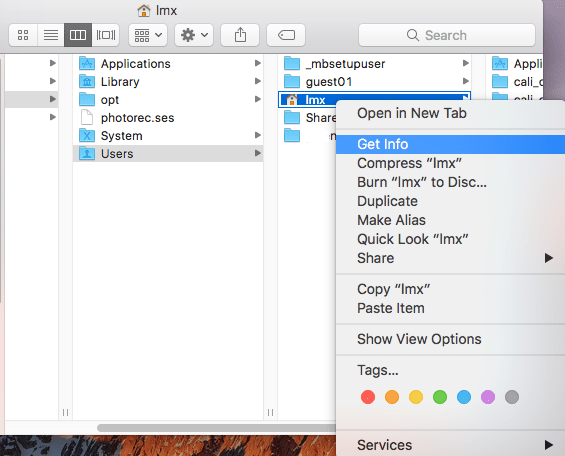Every item on your Mac, whether it’s a file or folder, has a set of permissions. Those determine who can view and modify data on your computer. If at some point you need to restrict access to some of your files, you can easily do that by changing permissions.
In this article, we’ll show you how to view and change file permissions, as well as how to stay in control of your application permissions. Let’s start!
What permission types are on Mac?
On your Mac, select an item, then choose File Get Info. Click the lock icon to unlock it. Enter an administrator name and password. In the Sharing & Permissions section, do any of the following: Add a user or group: Click the Add button below the list, select a user or group, then click Select. Remove a user or group: Select the user or group, then click the Remove button below the list. Click the Sharing & Permissions triangle to see the item permissions. How to change permissions for files, folders, or disks. The next step is to actually change the item permissions to whatever you want. Below are a few examples of how you can adjust permissions to your needs. Assign permissions to users and groups. On your Mac, choose a file. Hold down the Command and R keys on the keyboard and turn on the Mac. Let go when the Apple.
There are several types of permissions users can have on macOS:
This will open the Reset Password window which includes a section at the bottom labeled: Reset Home Directory Permissions and ACLs. Click the Reset button. When the Reset button changes to Done, select Restart from the Apple menu. There is more in-depth information about using Mac OS. Restore your keychain permissions for Office for Mac. If the above did not work, Office may have trouble accessing the keychain and you'll need to restore keychain permissions for Office for Mac. In these cases, you may see: The keychain access prompt every time you launch any Office application, even though you previously selected Always Allow.
- Read only — Allows a user to open the file, but not change it.
- Write only — Makes a folder into a drop box. A user can copy items to the drop box, but cannot open it. Only the owner of the drop box can open it.
- Read & Write — Allows a user to open the file and change it.
- No Access — Blocks access to the file.
How to view file permissions
Any user can view the file permissions using the Finder’s Info window. In Finder, right-click the file or folder and choose Get Info from the menu. Click the Sharing & Permissions triangle to see the item permissions.
How to change permissions for files, folders, or disks
The next step is to actually change the item permissions to whatever you want. Below are a few examples of how you can adjust permissions to your needs.
Assign permissions to users and groups
- On your Mac, choose a file or folder.
- Right-click it and select Get info.
- Click the disclosure triangle in the Sharing & Permissions block.
- Click the lock icon to unlock it.
- Enter the administrator name and password.
- Choose the user in the Name column and then choose Privilege setting from the pop-up menu.
Apply permissions to all files in a folder/disk
- Choose a folder or disk.
- Select File > Get Info.
- Click the lock icon to unlock it.
- Enter the administrator password.
- Click the Action pop-up menu and choose Apply to enclosed items.
Change a file’s owner
- On your Mac, choose the file.
- Click the lock icon to unlock it.
- Enter the administrator password.
- If the new owner’s name is not listed in the Name column in the Sharing & Permissions block, click the Add button to add the new owner.
- Choose the new owner in the Name column, click the Action pop-up menu, then choose Make_the owner.
How to control application permissions
The latest macOS versions introduced new security controls. Now apps have to request permission before accessing certain parts of your drive. For example, if you open Skype for the first time, you’ll get a pop-up asking permission to access your camera and microphone.
You can easily check what programs are allowed to use your webcam, microphone, files and folders. There are two ways to do that — via System Preferences or using a third-party app like CleanMyMac X.

Change app permissions via System Preferences
If you have a strange feeling that someone is watching or listening to you, you can check what apps have access to your camera or microphone. Here’s how to do that:
- Go to the Apple menu.
- Choose System Preferences > Security & Privacy.
- Select the Privacy tab.
- Choose Camera from the left menu.
- Check what apps are allowed to use your camera.
- Uncheck the box next to the apps you don’t want have access to your camera.
Note:
You can limit access to your camera or microphone only for third-party apps. Apple apps and bundled system apps will not show up in the camera access control list. So, for example, you won’t see FaceTime in the app permissions panel.

Control all permissions easily with CleanMyMac X
If you don’t feel like browsing your System Preferences in search of app permissions, there is an easier and faster way to manage them. Get yourself the app CleanMyMac X and use its freshly-baked feature “Application Permissions.” You’ll be able to view and manage all permissions from one place, in a matter of seconds.
Here’s how it works:
- Download and install CleanMyMac X (it has a free trial version)
- Launch the app.
- Go to the Privacy module.
- Click Scan.
- Choose Application Permissions.
- Check your permissions and adjust the ones you want.
As simple as that!
As long as you’ve already installed CleanMyMac X, we recommend you trying its other tools. Start from Smart Scan — a one-button solution for checking your Mac for unneeded junk files, viruses, and suitable speedup tasks.
That’s it. Now you know everything about permissions on your Mac and can adjust the settings to your personal needs. May your personal data be always safe and untouched!
What are disk permissions and why do they need repairing?
Disk permissions on macOS are used to keep your files secure. They’re designed so that certain programs (or other users if you share your Mac) can’t just dip into a system file they have no business with and modify it. They’d need permission to do that.
Every file and folder on your Mac comes with an associated set of permissions. From the Apple Community:
“Many things you install in Mac OS X are installed from package files (whose filename extension is '.pkg'). Each time something is installed from a package file, a 'Bill of Materials' file (whose filename extension is '.bom') is stored in the package's receipt file, which is kept in /Library/Receipts/ in Mac OS X v10.5 and earlier. These files don't take up much disk space and you shouldn't put them in the Trash. Each of those '.bom' files contains a list of the files installed by that package, and the proper permissions for each file.”
Unfortunately, these permissions can easily become messed up unintentionally. It’s quite common for this to happen when installing and uninstalling apps on your system. And when it does, apps can find themselves with free reign to alter files and modify read-only files which can cause all kinds of permission errors and system issues such as lagging, freezing, or crashing.
If you notice anything out of the norm regarding system performance, the first thing you should do is troubleshoot those disk permissions.
Below we’ll show you two ways: the manual and the easy one. Choose the way that works best for you.
How to repair permissions on Mac: The manual way
If you’re running an older version of macOS, Disk Utility is the go-to tool for troubleshooting problems.
Why an older version?
Because as of macOS version 10.11 El Capitan, Disk Utility no longer comes with the option 'repair disk permissions'. Boooo!
Apple even removed the command line:
But there’s a method to the madness. macOS now comes with a feature called System Integrity Performance (SIP) which is designed to automatically repair file permissions during software updates and system changes. SIP works by restricting the root account so that it can’t do things like modify protected locations and processes such as /System and /usr. This should prevent malware from gaining root permissions and infecting your system files.
Anyway, back to using Disk Utility to repair disk permissions. If you’re running a pre-El Capitan version of macOS, follow these steps:
1. Press Command + Space to open Spotlight, type in “Disk Utility”, and hit Enter.
2. Select Macintosh HD from the left sidebar menu.
3. Click on the First Aid tab.
4. Click on Verify Disk Permissions. By taking this step, Disk Utility will work through your hard drive to detect broken or misbehaving permissions and list them for repair. This might take a few minutes but you can check the Show details box to keep an eye on its progress.
5. Click on Repair Disk Permissions and wait while Disk Utility runs through the identified permissions to fix them.
Permissions Reset Mac Os X
If disk permission issues have played such havoc that your Mac won’t boot correctly, it’s possible to access Disk Utility in Recovery Mode. Do this by holding Command + R during bootup.
If you’re installing a newer (or older) version of macOS on top of your existing operating system, Mac will perform a disk permission repair as a part of the installation so that you start from a clean slate.

How to repair disk permissions on Mac: The easy way
For users of macOS versions El Capitan and newer, the removal of Repair Disk Permissions means you have no troubleshooting solution to turn to in if your Mac is ailing.
But worry not, CleanMyMac X is the hero you need.
Permissions Reset Mac App
CleanMyMac is like Disk Utility in that it does all of the heavy lifting for you to verify permissions and repair your Mac’s disk.
Even System Integrity Performance running quietly in the background doesn’t prevent certain issues from arising. If you’re suffering from any of the following problems, boot up CleanMyMac and have it take care of business:
- Improper functioning of applications.
- Inability to move or delete files.
- Inability to access files.
If you Mac appears to be running fine, it’s still worth running repairs every so often to ensure it stays that way. Not all broken permissions affect performance but that doesn’t mean they shouldn’t be fixed.
Repairing Disk Permissions in a few clicks
First things first, you’ll need to download CleanMyMac X. You can do that here. It’s free so you won’t need your credit card. Once that’s done, follow these five steps:
1. Launch CleanMyMac.
2. Click on Maintenance from the left sidebar menu.
3. Check the box next to Repair Disk Permissions.
4. Click Run.
CleanMyMac will scan your system to verify disk permissions and automatically repair permissions that are found to be faulty. When the task is complete, you’ll be able to view a log of all the permissions that were repaired.
And that’s all there is to it. Your Mac should now be running as intended.
Disk permissions are critical to your system’s security and performance but only when they’re working as they should. Use CleanMyMac to verify and repair disk permissions whenever you run into issues with apps or files for a healthy running Mac.

Enjoy a clean, happy Mac!
Reset File Permissions Mac
These might also interest you:
